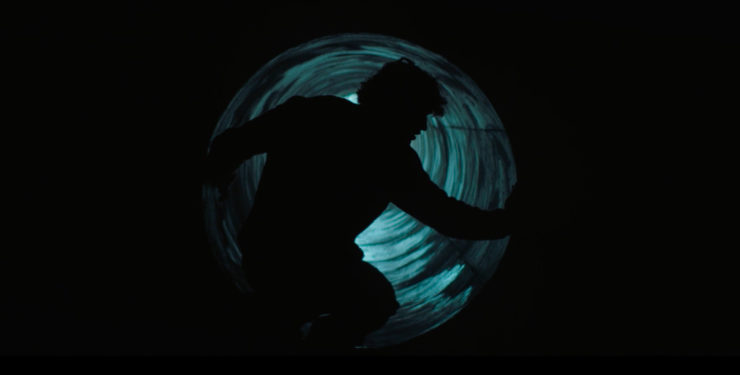Halloween Ends opens its main action with a voiceover from none other than Laurie Strode (Jamie Lee Curtis), in what initially seems like a cheeky nod to the inciting action of the 2018 Halloween reboot: Is she recording a podcast?? After the duo of opportunistic true-crime enthusiasts got eviscerated in a gas station for trying to goad Michael Myers (James Jude Courtney) back into stalking Laurie with intent to finally kill her, would Laurie have gotten her darkly comic revenge by turning her admittedly very lucrative life story into entertainment, very Only Murders in Haddonfield?
But no, this Final Girl (who has had a makeover into Final Grandma) prefers to type out her story in memoir form, complete with florid metaphors and overwrought declarations. Unfortunately (as this brilliant tweet points out) the voiceover is giving big Carrie “I couldn’t help but wonder” Bradshaw vibes. Aside from that laugh, this encapsulates to what extent the final volume in this trilogy has lost sight of what made the franchise reboot so damn good. It starts with a podcast but ends with a hackneyed autobiography; it’s purportedly a pandemic film that replaces covid-19 with a vague “plague” of evil. It’s as if director David Gordon Green and co-writer Danny McBride trusted neither themselves nor their audiences with their first idea, instead forcing in “twists” that undermine their own groundwork that they’ve spent the last four years constructing… a lot like building a salvage yard on top of what used to be a haunted house.
This piece contains spoilers for Halloween Ends.
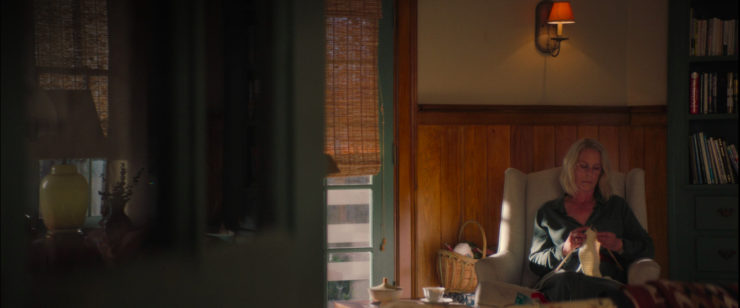
Green had originally given the impression that Halloween Ends would take place in our present, i.e., two and a half years into the covid pandemic. The notion of combining Haddonfield’s recurring bloody Halloweens—like a slasher flu season—with a world in which people have proven themselves to think the worst of others would have been a compelling new dimension to salvage the mess that was Halloween Kills. Instead, the filmmakers went weirdly figurative: Even though Michael seemingly disappears after his 2018 massacre, the next Halloween sees Haddonfield gripped by “a plague of grief, of blame, of paranoia” due to a series of violent yet random killings.
But the patient zero, as it were, of this new plague is the terrible accident that turns Corey Cunningham (Rohan Campbell) into a pariah: Through a series of awful misfortunes, the twentysomething babysitter accidentally sends his young charge falling down multiple flights to his death, right in front of his horrified parents. Even though it was Final Destination levels of bad luck, Corey becomes Haddonfield’s new Michael Myers: a scapegoat for all of the town’s worst impulses, the babysitter killer instead of the babysitter victim.
As sympathetic as Corey’s situation is, the filmmakers want us to believe that his life in 2022—cleared of the charge of manslaughter but obviously depressed, working at the salvage yard, might as well bear a scarlet M—is anything like that of Allyson (Andi Matichak), who lost both of her parents to Michael’s knife and who feels obligated to stay in a dead-end job in Haddonfield so that her grandmother will have something solid to hold onto. Despite having established a fascinating dynamic between Allyson and Laurie in Halloween, this final film sees them completely misunderstanding one another, each trying to be something they think the other wants, instead of remembering that they always got each other better and it was poor Karen (Judy Greer) caught in the middle. The film contrives conflict where there shouldn’t be, all to shoehorn in a lackluster romance between Allyson and Corey.
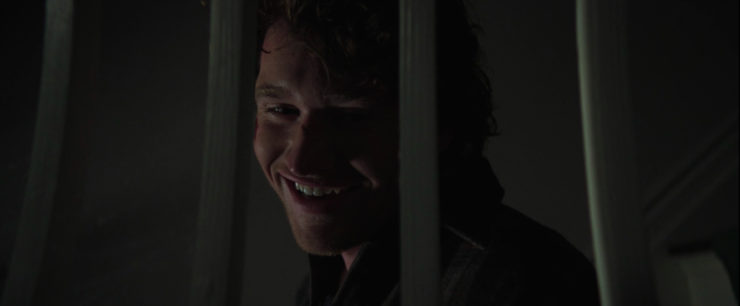
But Corey is about to test positive for… Shapeavirus? Because it turns out that Michael Myers has been hiding in the sewers this whole time, occasionally kidnapping and killing (and eating?? who knows!) random people. Continuing this unfortunate pandemic metaphor, Michael either possesses Corey or simply decides not to kill the younger man because he recognizes some of the same darkness in him. Regardless, Corey uses his brush with death to give in to his resentment of his neighbors by donning a clown mask and stabbing those who’ve wronged him and/or Allyson. It’s unclear if the encounter with Michael somehow gave Corey carte blanche to become the killer that everyone already thinks he is, but he gets very cocky very quickly; he lurks outside Laurie’s home mimicking Michael’s stance, decides that he and Allyson are going to run away together, and even decides to fight Michael for his mask.
Then he has the gall to accuse Laurie of exactly the same thing that everyone in Haddonfield has for the past forty years: It’s your fault. Michael only killed everyone because he was trying to get to you. You provoked him. You tempted him. You welcomed him (me) in.
This. Fucking. Punk. Look, I’m not saying that Green and McBride were inaccurate by having their new antagonist be a socially stunted white boy whose young adulthood was ruined by a misunderstanding and who feels that his future is wiped out, so he may as well lean into that resentment and victimhood. But… that’s not what this franchise reboot was initially about. Halloween examined decades of inherited trauma among three women and the contradictory ways in which they responded to the looming threat of their personal Bogeyman. Halloween Ends has compromised the integrity of Laurie and Allyson both in order to fit them around Corey’s vendetta.
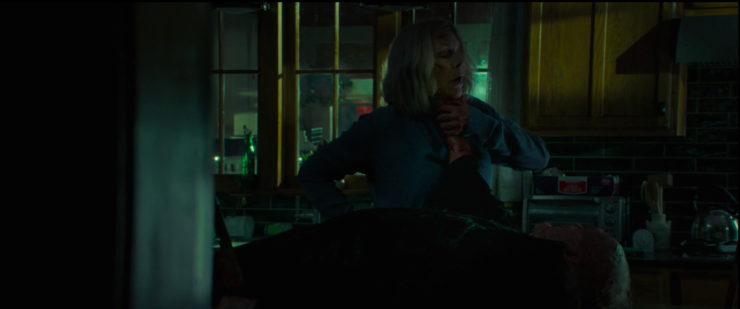
By the time that Michael shows up to get his mask back, it’s almost a relief to get back to brass tacks: Michael versus Laurie, the same dance from four years ago as from forty years ago. But it also makes no damn sense why Michael would have wasted all this time hiding in the tunnels, unless killing in tandem with Corey somehow brought back the love of the kill?
What came across as cleverly self-aware in prior movies only manages to be self-conscious here, like the Chekhov’s kitchen island in Laurie’s new home. But instead of Halloween’s brilliant transformation of the hidden space from Karen’s fear trap to Michael’s ostensibly final prison, Halloween Ends attempts to subvert its own imagery: You expect again for the island to slide away and reveal an even more tricked-out panic room, but instead the island stays put—a solid canvas upon which Laurie pins Michael by a series of kitchen knives. He bleeds out on the wood like an animal being butchered, but every new thunk of a knife feels more gratuitous than satisfying.
The motif that worked a lot more subtly was that of timers: At the start, Laurie flies into a tizzy about forgetting to set a timer for the pie that she bakes to a comically blackened crisp, ruining the idyllic family tableau for an impatient Allyson. Later, when Michael is chasing her through the house, her microwave is whirring away on heating up some frozen food, acting as a distraction and a countdown clock for their final showdown.
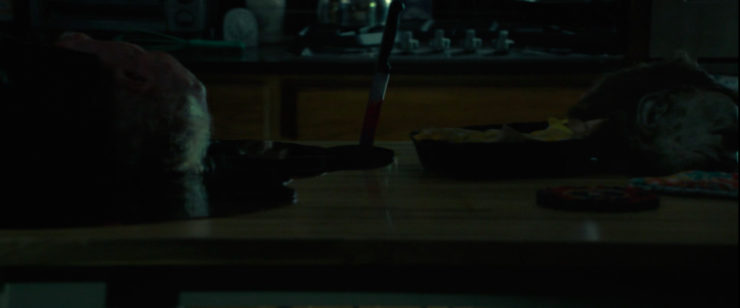
Unfortunately, small thoughtful moments like that are all too rare, with the movie leaning more on big sequences like the town of Haddonfield putting on a macabre Halloween parade and ferrying Michael’s corpse to—you guessed it—the salvage yard on top of what used to be his childhood home where this all began. In the same place that broke the young boy into sharp pieces to be put back together wrong, the man is ground back up into pieces. An apt metaphor for this movie completely falling apart.
Despite the surviving Strode women turning Michael’s signature weapon against him, his death (supposedly for good this time) lacks any real catharsis. Ironically, the moment in Halloween when he was standing below that first kitchen island, staring up at the three women right before the flames engulfed him, was so much more powerful. Green and McBride should have left things there.
Halloween Ends is in theaters and streaming on Peacock.
Natalie Zutter wishes the movie had done more with the weird murder threesome, but also she’s glad this long ordeal is finally over. Talk better horror reboots—or honestly, better horror that doesn’t traffic in nostalgia!—with her on Twitter.










